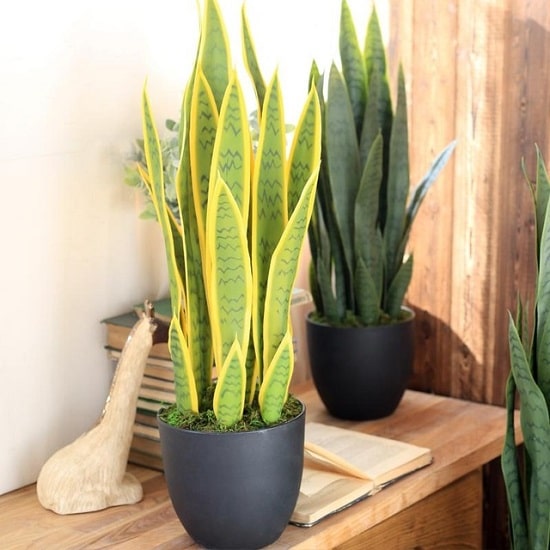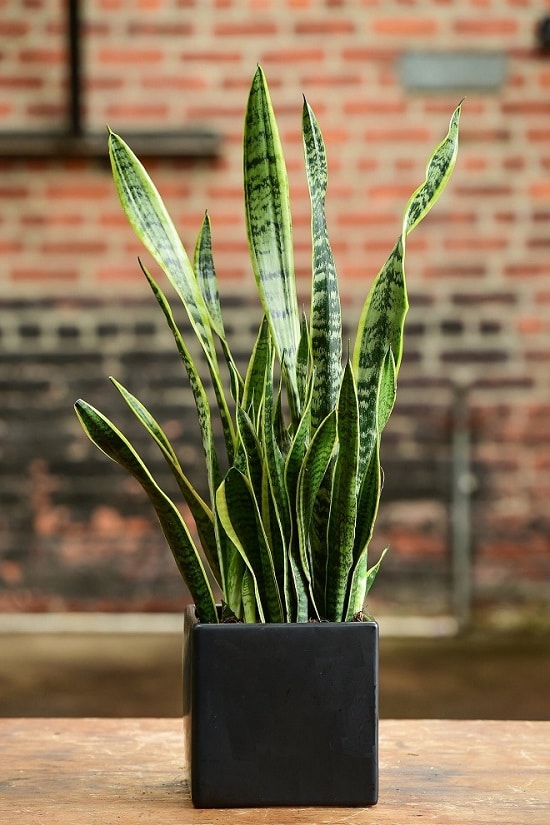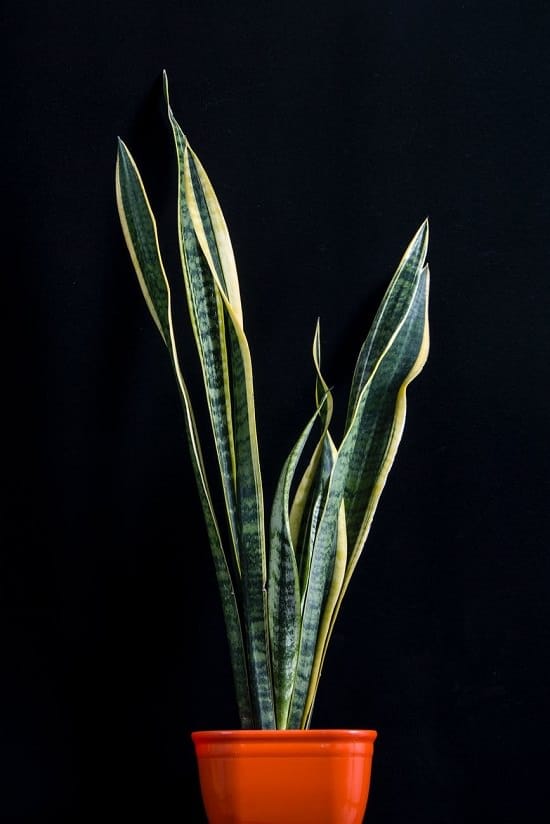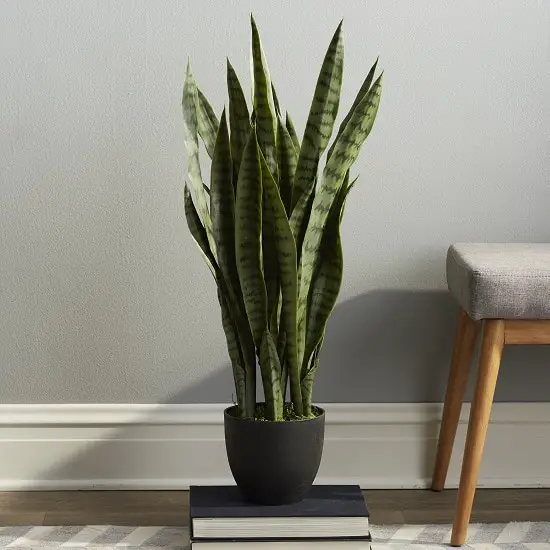After learning these Snake Plant Benefits proven in research and studies of top organizations, you would like to grow this houseplant immediately!
 Snake Plant Benefits are many, this is why it is one of the best selling houseplants in the world. If you don’t have one yet, this article will surely tempt you into growing one in your room!
Snake Plant Benefits are many, this is why it is one of the best selling houseplants in the world. If you don’t have one yet, this article will surely tempt you into growing one in your room!
Common Name: Mother-in-law’s tongue, Viper’s bowstring hemp
Botanical Name: Dracaena/Sansevieria trifasciata
A study published recently claims that indoor air pollution can be as deadlier as outdoor air pollution. There are many ways to reduce indoor air pollution; these two articles from the University of Kentucky Extension and NASD point out the sources well and control them.
Learn the best tip for Growing Snake Plants
Snake Plant Benefits You Should Know About
1. A Great Oxygen Producing Houseplant
An abstract of the study published in Harvard University Extension observes that the snake plant is one of the best oxygen-producing indoor plants. Ficus and pothos are other plants that made the list.
2. It Looks so Nice!

It looks so nice and unique; this is why we also added it to our list of Architectural houseplants. The unsloped, thick, and tall foliage without stems looks so modern, and on top of it, the shades of green, yellow, or gray with the horizontal stripes make it a desired indoor plant.
3. It Removes Air Pollutants
One of the best snake plant health benefits is its small contribution to eliminating toxic air pollutants. Other than CO2, it can absorb benzene, formaldehyde, xylene, and toluene. These cancer-causing pollutants are harmful to our health, a well-known proven fact.
The famous NASA experiment of 1989 on indoor plants proved that plants with more leaf surface area (leafier and bigger plants) do better air purification, and the snake plant is one of them.
a. Carbon Dioxide
A study published in 2015 on Indoor CO2 consequences indicates that humans who breathe more carbon dioxide in the home, workplace, and classroom face difficulty in performing and learning. Raised CO2 levels directly affect our cognitive skills and productivity; dizziness and nausea are other consequences.
Snake plant, aka Mother-in-law’s tongue, absorbs CO2 effectively. A study conducted at Naresuan University, Thailand, with 60-80 cm tall snake plants (Sansevieria trifasciata) revealed that CO2 level in offices was reduced with 4-5 snake plants. Check it out here!
b. Benzene
Exposure to benzene in the indoor environment is widespread. From heating and cooling systems, solvents, paints, smoking cigarettes, etc. Check out this educational article from WHO. Headaches, nausea, and vomiting can be caused if you are exposed to benzene. Chronic exposure to benzene causes cancers related to blood cells, proven in a lot of medical research.
Besides taking other measures, you can grow snake plants in your home. It absorbs benzene. If you look at the NASA study, you’ll see that the snake plant (Mother-in-Law’s Tongue) removed 52.6 percent in a sealed chamber. The initial p/m was 0.156, which was reduced to 0.074 p/m in the final reading after 24 hours.
c. Formaldehyde
The significant sources of formaldehyde emission are cooking, smoking, cosmetics, paints, fuel combustion from traffic, etc. Newly-made homes, flooring, furniture, and new products must be considered as well.
Formaldehyde is also on the list of WHO guidelines for indoor air quality. This educational article at ATSDR on formaldehyde provides great information. Raised levels of formaldehyde cause breathing problems and irritation in the eyes, nose, and throat. Chronic exposure to it can cause rare nose and throat cancers.
Snake plant is one of the finest indoor plants that lower formaldehyde levels! In the NASA experiment, a single plant removed 31,294 micrograms in 24 hours of exposure in a closed chamber.
d. Xylene
Xylene is hazardous to humans, and it has been reported well here. You can get exposed to it from paint, varnish, rust preventives, paint thinners, removers, and pesticides. You’ll experience nose and throat irritation if xylene is present in a small concentration in the surrounding.
Here again, snake plants and many other houseplants like mum and areca palm are your friends when it comes to xylene removal.
e. Trichloroethylene & Toluene
Trichloroethylene (TCE) is found in printing inks, lacquers, paint removers, varnishes, and adhesives. Here’s a list of some TCE products. TCE is carcinogenic and can irritate the upper respiratory tract and cause nausea, fatigue, and headache.
Toluene affects mental health and causes dysfunction in the nervous system. Long-term exposure to toluene is also known to cause necrosis. It also affects the reproductive system of females and causes developmental problems in children. Gasoline, solvents in paints, plastic and soda bottles, paint cosmetics are its major source.
To lower the risk of Trichloroethylene and Toluene exposure, grow a snake plant indoors. In the experiment, it removed up to 13.4 percent of TCE in 24 hours of exposure.
4. It Absorbs CO2 in the Night
It’s a question of confusion and disbelief that snake plants or any other plant continuously release oxygen in the nighttime. We don’t find any substantial evidence to prove that. However, snake plant indeed reduces the CO2 even in the night.
Due to the Crassulacean Acid Metabolism (CAM), the capability to perform a particular type of photosynthesis. CAM plants are drought-tolerant, dry climate plants, for example, succulents. They open their stomata in the evening to minimize water loss in hot conditions.
5. It is Effective Against Allergies
A plant that releases oxygen reduces CO2, and absorbs harmful volatile organic compounds can surely decrease the odds of airborne allergies. The snake plant is one such plant! Even if you’re using air filters and purifiers and have good ventilation, surrounding yourself with indoor plants helps.
Check out this educative article available at the University of Hawaii Extension to learn more.
6. For Protective Energy and Feng Shui
Some people believe that the snake plant is not a good plant when it comes to feng shui. It is far from being true. If placed in an ideal position, it brings protective and purifying energy to the home or office.
In feng shui, spiky plants are considered excellent against negative Chi. As they are so aggressive, you need to place them in less trafficked areas. Some of the best spots are Southeastern, Southern, and Eastern corners.
7. It is Low Maintenance

With all the other Snake Plant Benefits and facts listed above, one more to add is it’s one of the best low-maintenance houseplants in the world. It can thrive in full sun, in full shade, and in lack of water. Basically, it thrives on neglect. We also added it to our list of Easiest Houseplants. Check it out here!






thank you.very informative.
Very informative. please tell what other plants in balcony can be grown where there is direct sun light. Which type of good rose flower varieties are available in the market and whether it is is right season to plant them.
Thanks for this INFO 👍🏼😊
Thank you so much for information and its benefits. I am using snake plant in my bed room.
After reading this, I bought one!!
Appreciated. Helpful information. Thank you. 🙏
thx for info
helped a lot
Very informative artical n it is helpful for every nature lover.thanks a lot
Useful info.
Love Snake Plants. Just started growing them.
I have hundreds growing in my back yard. It’s time to bring some inside to purify the air. I’m sure they’ll make wonderful gifts for family and friends.
Over the summer i bought three snake plants from IKEA and i absolutely love them.
Snake Plant is the best plant among indoor plants. Well Informative Post.
Very informative. Thank you
I learned a lot in this article. I have the snake plant. I love them. Thank u for sharing
I learned a lot about the snake plant I have a few of them myself. I enjoy them. Thank you for sharing
Which of the snake is used as herbal medicine
Do snake plants cure cancer in a tea to drink?
Looking forward to seeing the results